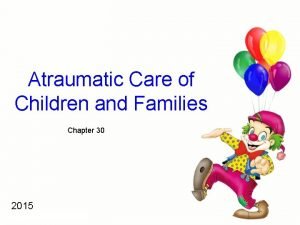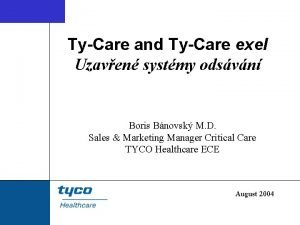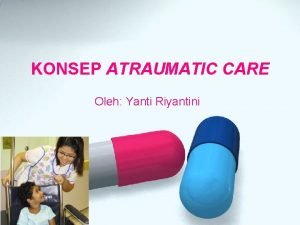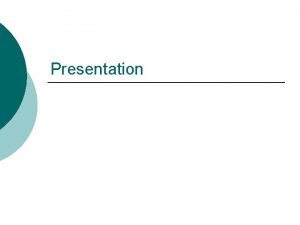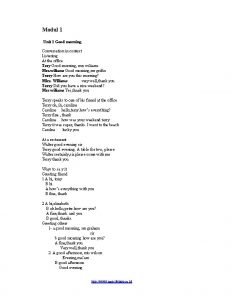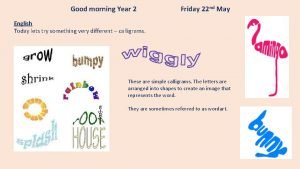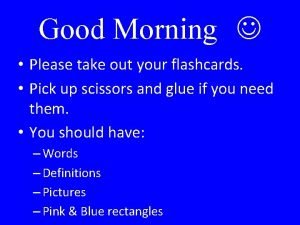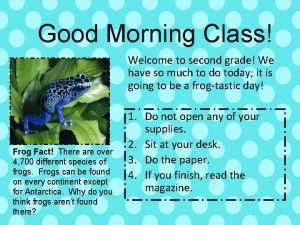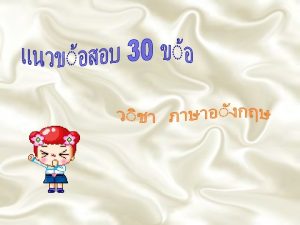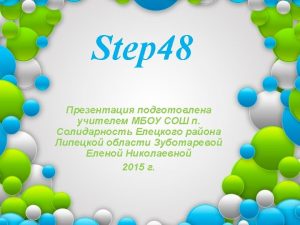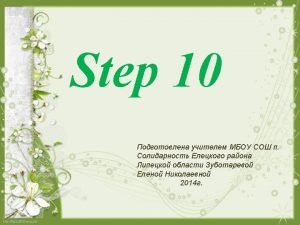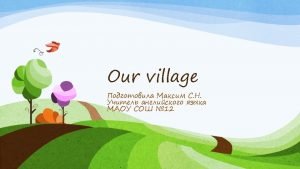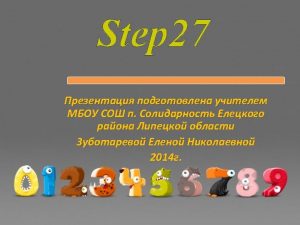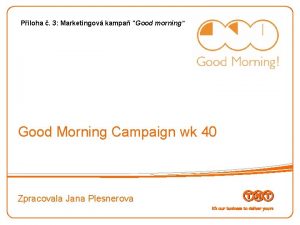Good morning ATRAUMATIC RESTORATIVE TREATMENT ART Dr Neha







































































- Slides: 71

Good morning

ATRAUMATIC RESTORATIVE TREATMENT (ART) Dr Neha Agrawal

CONTENTS n Introduction n Definition n History and its development n Principles n Indications and contraindications n Essential instruments and materials

n Technique § Glass-ionomer used as a sealant § Monitoring restorations and sealants n How effective is ART? n Applications of ART n Advantages and limitations of ART n What not to forget n Conclusion

INTRODUCTION

Not available, not affordable Caries process progresses beyond the reversible stage and requires restorative treatment

n In most industrialized countries, conventional restorative treatment Requires sophisticated and expensive equipment and extensively trained health care providers

In developing countries, lack of restorative care to needy populations Ø not possible to reach remote populations with modern dental equipment Ø acute shortage of trained personnel Ø lack of electricity Ø Ø inadequate motivation of rural communities through lack of education and information fear of dental treatment

Consequently, n n High prevalence of untreated caries Main method of treating dental caries is dental extraction under emergency conditions

n n In communities with few dental facilities and providers, alternative measures for treating caries are being developed. One alternative operative approach to manage carious lesions was tested in Africa in the mid 1980 s, which became known as the Atraumatic Restorative Treatment.

DEFINITION Alternative Restorative Treatment : American Academy of Pediatric Dentistry “a dental caries treatment procedure involving the removal of soft, demineralized tooth tissue using hand instrument alone, followed by restoration of the tooth with an adhesive restorative material, routinely glass ionomer”.

HISTORY AND ITS DEVELOPMENT n mid-1980 s: Pioneered in Tanzania as part of a community-based primary oral health program by the University of Dar es Salaam.

n 1988: WHO Collaborating Centre for Oral Health Services Research at the University of Groningen, the Netherlands developed a model for primary oral health care for refugees and displaced persons, which included treatment of caries by hand instruments only.

n 1991: Community field trial to compare ART with the mobile conventional equipment (cavity preparationamalgam) approach started in rural Thailand with the assistance of Professor Prathip Phantumvanit, Dr. Yupin Songpaisan and the staff of the University of Khon Kaen, in north-eastern Thailand. n 1993: Dr. Jo Frencken started another series of community field trials in Zimbabwe

n Manual prepared by Dr. Jo Frencken, n. Dr. Evert van Amerongen, n. Prof. Prathip Phantumvanit, n. Dr. Yupin Songpaisan and n. Prof. Taco Pilot n Original English version translated into French, Spanish, Portuguese, Japanese, Chinese, Arabic and languages of Thailand, Laos, Cambodia, Vietnam, Indonesia, Malaysia and Mangolia

1994 Official adoption of ART by WHO on Oral Health Day 1995: Symposium devoted to ART held at the IADR Singapore meeting. An electronic information network (ART-ODONT) was launched.

n By 1996: ART being used in 25 countries. ART field trials in progress in 11 countries and further 17 countries had plans to begin field trials

2002: n n One of the 3 key components of Basic Package of Oral Care, developed to meet the principles of Primary Health Care by WHO. ART adopted by FDI at the annual meeting in Vienna.

The Indian scenario n n High prevalence of dental caries (52% in 5 years to 85% in 65 -74 years) High prevalence of unmet treatment needs (5 years: 50% , 12 years: 60. 2%, 65 -74 years: 80. 5%) Lack of dental manpower Dentist/population ratio in the rural areas is only 1: 300, 000. Atraumatic restorative treatment is being tested through the Maulana Azad Dental College in Delhi.

PRINCIPLES OF ART The two main principles of ART are: n n removing carious tooth tissues using hand instruments only restoring the cavity with a restorative material that sticks to the tooth. Currently, ART is performed using glass-ionomer as the restorative material.

Reasons for using hand instruments: n n n makes restorative care accessible for all population groups minimal cavity preparation that conserves sound tooth tissues and causes less trauma to the teeth low cost of hand instruments compared to electrically driven dental equipment Limits removal of tooth tissue to removal of dead and therefore insensitive tooth tissue – limitation of pain simplified infection control

Reasons for using glass-ionomer are: n n n as the glass-ionomer bonds chemically to both enamel and dentine, the need to cut sound tooth tissue to prepare the cavity is reduced, fluoride is released from the restoration to prevent and arrest caries it is rather similar to hard oral tissues and does not inflame the pulp or gingiva.

INDICATIONS AND CONTRAINDICATIONS In general, ART can be applied when: n n there is a cavity involving the dentine, and that cavity is accessible to hand instruments.

ART should not be used when: n n presence of swelling or fistula near the carious tooth pulp of the tooth is exposed teeth have been painful for a long time and there may be chronic inflammation of the pulp there is an obvious carious cavity, but the opening is inaccessible to hand instruments

Figure 1. Various types of one-surface carious cavities

Figure 2. Various types of multiple-surface carious cavities.

ESSENTIAL INSTRUMENTS AND MATERIALS Instruments for ART 1. 2. 3. 4. 5. 6. 7. mouth mirror explorer a pair of tweezers spoon excavator hatchet or hoe e. g. Ash 10 -6 -12 Applier/ Carver e. g. Ash 6 Special mixing-pad and spatula

n n In a clinic, instruments can be sterilized in an autoclave or a pressure cooker. If not in the clinic, a pressure cooker or a pan with a lid to boil the instruments can be used

Materials for ART 1. Gloves 2. Cotton wool rolls 3. Cotton wool pellets 4. Plastic strip 5. Wedges 6. Glass ionomer restorative material 7. Dentin conditioner 8. Petroleum jelly

Composition of glass-ionomer cement n n Powder : a glass containing silicon-oxide, aluminum-oxide and calcium fluoride. Liquid : either polyacrylic acid or de-mineralized water. If de-mineralized water is the liquid component, polyacrylic acid is incorporated into the powder in a dry form.

n Recently, several more-viscous GIC restorative materials with improved handling and mechanical properties, mainly as a result of smaller particle sizes, have been marketed specifically for use with the ART approach. Examples: n n Fuji IX GP Ketac-Molar Chem. Flex

TECHNIQUE

A. Operating positions and lighting Operator's work posture and positions n Sits firmly on a stool, with straight back, thighs parallel to the floor and both feet flat on the floor. n Distance from operator's eye to patient's tooth : 30 and 35 cm. n Range of positions : 10 to 1 on the clock. n Most commonly used positions: n direct rear position (12 o'clock) and n right rear position (10 o'clock)

Seating Position of Assistant n n Assistant works at the left side of a right-handed operator. Assistant's head should be 10 - 15 cm higher than the operator, so that the assistant can also see the operating field and can pass the correct instruments when needed

Patient Position n n The patient is made to lie on the back on a flat surface. e. g. a bamboo or wooden bed, a table or an appropriate portable dental bed A headrest made of firm foam or a rubber ring with a cover- stabilizes the patient's head in the desired position and improves the comfort of the patient.

Patient's Head Positions 1. Tilting the head 2. Turning the head 3. Mouth opening a. Fully open. b. Partly closed

Operating Positions Position for upper left posterior - occlusal surfaces Position for upper right posterior - occlusal surfaces

Lower right posterior position occlusal and lingual surfaces Position for lower left posteriorocclusal surfaces

Operating Light n n n The light source can be natural or artificial. Artificial light : more reliable, constant and can also be focused on a particular spot. In a field setting a portable light source recommended e. g. headlamp, glasses with a light source attached or a light attached to the mouth mirror

B. Isolation A very important aspect for the success of ART is control of saliva around the tooth being treated. Cotton wool rolls quite effective at absorbing saliva and can provide short-term protection from moisture/saliva.

C. Preparing the Cavity n Remove plaque from the tooth surface with a wet cotton wool pellet, and then dry the surface with a dry pellet.

n n If the cavity opening in the enamel is small, widen the entrance by placing the blade of the dental hatchet into the cavity and turning the instrument forward and backward like turning a key in a lock. If the cavity is very small, place a corner of the blade of the dental hatchet in the cavity first and then turn.

n n Carious dentine removed with excavator by making circular scooping movements around the long axes of the instrument. It is important to remove all the soft caries from the enamel-dentine junction before removing caries near the pulp.

n Overhanging enamel must be removed with the blade of the dental hatchet. Place the instrument at the edge of the enamel and fracture off small pieces.

For multiple-surface restorations

D. Cleaning the Prepared Cavity In order to improve the chemical bonding of glass-ionomer to the tooth structures, the cavity walls must be very clean. n n a dentine conditioner the liquid supplied with the glass-ionomer itself.

E. Restoration of prepared cavity n Mixing of restorative material should be completed within 20 -30 seconds

n Insert the mixture into the cavity in small amounts using the blunt end of the applier/carver instrument.

n Rub a small amount of petroleum jelly on the gloved index finger and press the soft restorative material firmly into the cavity and fissures: the press-finger technique.

n n The excess material is removed with a carver. After about 1 to 2 minutes check the bite. The height of the restoration can then be adjusted with the carver blade of the applier/carver Cover the ART restoration with a new layer of petroleum jelly The patient is not allowed to eat for at least 1 hour.

n Restoring a proximal surface cavity in an anterior tooth

n Restorative procedures for multiplesurface cavities in posterior teeth

GLASS-IONOMER USED AS A SEALANT n n Besides being used as a restorative material, glass-ionomer can also be used as a sealant. The ART approach uses the same glassionomer for both restorations and sealants.

n Rationale n Physical barrier n n Number of viable microorganisms left beneath sealant decreases with time. Even when glass-ionomer sealants have been partly or completely lost, there is usually a benefit to the patient because the fluoride released from the material will have made the enamel harder.

n n Indications Only place sealants in deep pits and fissures, which show signs of early tooth decay. Do not place sealants in pits and fissures, which are deep and colored dark. The dark color is usually a sign that caries has come to a halt. place a sealant when the dark colored pits and fissures are surrounded with a clear whitish discoloration. The latter is a sign of early tooth decay.

Procedure 1. 2. 3. 4. Isolate the tooth with cotton wool rolls. Clean the surface from debris with a cotton wool pellet dipped in water. Gently remove debris from deepest parts of pit and fissures with an explorer. Apply dentine conditioner or diluted glassionomer liquid into the pits and fissures for 1015 seconds.

5. Immediately wash the pits and fissures, using wet cotton wool pellets to clean off the conditioner. Wash 2 -3 times. 6. Dry the pits and fissures with cotton wool pellets. 7. Mix the glass-ionomer and apply it in all pits and fissures with the blunt blade of the applier/carver. Overfill slightly. 8. Rub some petroleum jelly on the gloved index finger. 9. Put the index finger on the mixture, press and remove finger sideways after a few seconds.

10. Remove visible excess of mixture with a large excavator. 11. Wait 1 -2 minutes till the material feels hard, whilst keeping the tooth dry. 12. Check the bite using the articulation paper and adjust the amount of sealant with the carver if needed. 13. Apply a new layer of petroleum jelly. 14. Remove cotton wool rolls. 15. Ask the patient not to eat for at least one hour.

Monitoring restorations and sealants When to monitor n Ask patients about pain felt during and after treatment, and their overall satisfaction within a period of 4 weeks after being treated. n First clinical evaluation - after half a year. n Further evaluations : on an annual or biannual basis

n Failed or Defective Sealant Examine the tooth carefully for signs of caries. § § If the surface is hard, leave it alone. If the surface is carious, reseal or make a small restoration depending on the extent of the defective sealant or of the caries present.

Restoration is completely missing Some of the reasons for failure could be: n contamination with saliva or blood during the restorative procedure, n mix of material was too wet or too dry, n not all the soft caries had been removed, n thin undermined enamel had been left behind, and this later broke off. Whatever the reason, clean the cavity completely, apply dentine conditioner and refill the cavity.

APPLICATIONS OF ART n Originally introduced for economically less developed populations.

Also has applications in the industrialized countries: n Introducing oral care to very young children, not previously exposed to dentistry n For patients with extreme fear/anxiety n For mentally and/or physically handicapped patients n In high-risk caries clinics, as an intermediate treatment, to stabilize conditions

For the home-bound elderly and those living in nursing homes ART was tested in 1997 -1999 in Helsinki, Finland among 119 old people (mean age 72. 5 years) living in their homes and receiving community-based support services (Honkala S and Honkala E, 2002)

ADVANTAGES AND LIMITATIONS Advantages n n n use of easily available and relatively inexpensive hand instruments rather than expensive electrically driven dental equipment; biologically friendly approach involving the removal of only decalcified tooth tissues, which results in relatively small cavities and conserves sound tooth tissue; limitation of pain, thereby minimizing the need for local anesthesia;

Advantages… n n a straightforward and simple infection control practice without the need to use sequentially autoclaved handpieces the chemical adhesion of glass ionomers, that reduces the need to cut sound tooth tissue for retention of the restorative material; the leaching of fluoride from glass ionomers, which prevents secondary caries development and probably remineralizes carious dentin; the combination of a preventive and curative treatment in one procedure; n the ease of repairing defects in the restoration; and n the low cost

Limitations Ø Ø long-term survival rates for glass-ionomer ART restorations and sealants are not available the technique’s acceptance by oral health care personnel is not yet assured; use limited to small- and medium-sized, one-surface lesions because of low wear resistance and strength of existing glass ionomer materials. possibility exists for hand fatigue from the use of hand instruments over long periods;

Limitations… Ø hand mixing might produce a relatively unstandardized mix of glass ionomer, varying among operators and different geographical/climatic situations; Ø misapprehension that can ART can be performed easily -this is not the case and each step must be carried out to perfection; Ø a misconception by the public that the new glass ionomer “white fillings” are only temporary dressings.

WHAT NOT TO FORGET n Treating dental caries using the ART approach without emphasis on preventive measures is a job only half done. Important to explain to people how they can prevent dental caries from affecting other teeth. 1. removal of plaque 2. counselling on proper diet 3. application of fluorides 4. application of antimicrobial agents 5. application of sealants n

CONCLUSION n n n ART is a minimally invasive and patient-friendly technique, which can be adopted as a primary health care approach due to its less-sophisticated nature. Although the results are promising, short term clinical studies have revealed less than ideal restoration and sealant survival rates. Further improvements in the mechanical and adhesive properties of the newer GICs are required to ensure their optimal long-term clinical performance.

“Atraumatic Restorative Treatment is abbreviated as ART. And art is something nice, beautiful, enjoyable…
 Good afternoon me
Good afternoon me Good morning professor eng
Good morning professor eng Good morning teacher
Good morning teacher Good morning everybody how are you
Good morning everybody how are you Good night i am glad to see you
Good night i am glad to see you Hello and good evening
Hello and good evening Good afternoon animado
Good afternoon animado Greetings and responses
Greetings and responses Gentlemen good night ladies good morning
Gentlemen good night ladies good morning Punktualizmus
Punktualizmus Good morning good lookin
Good morning good lookin Good morning students,
Good morning students, Gentlemen good night ladies good morning
Gentlemen good night ladies good morning Color coding for waste disposal
Color coding for waste disposal Jamie fu
Jamie fu Neha pahuja
Neha pahuja Neha urkude
Neha urkude Victoria ding
Victoria ding Neha premkumar
Neha premkumar Good thoughts good words good actions
Good thoughts good words good actions You are good you are good when theres nothing good in me
You are good you are good when theres nothing good in me Nobody loves me poem
Nobody loves me poem Morning bells are ringing
Morning bells are ringing Autramatic care
Autramatic care Atraumatic care pediatric nursing
Atraumatic care pediatric nursing Atraumatic care definition
Atraumatic care definition Tycare
Tycare Prairie cardiovascular consultants springfield il
Prairie cardiovascular consultants springfield il Konsep atraumatic care
Konsep atraumatic care You are good in the morning i sing
You are good in the morning i sing Good morning campers today's challenge is simple
Good morning campers today's challenge is simple Receptionist good evening
Receptionist good evening Good morning and welcome back
Good morning and welcome back Assalamualaikum greetings
Assalamualaikum greetings Good morning 1 june
Good morning 1 june Ladies and gentlemen good morning
Ladies and gentlemen good morning Conversation good morning
Conversation good morning Hi everyone good afternoon
Hi everyone good afternoon Good morning welcome june
Good morning welcome june Good morning campers today's challenge is simple
Good morning campers today's challenge is simple Good morning welcome back
Good morning welcome back Good morning one and all
Good morning one and all Good morning students how are you today
Good morning students how are you today Good morning student
Good morning student Good morning flashcards
Good morning flashcards Good morning please have a seat
Good morning please have a seat Theobald von bethmann hollweg
Theobald von bethmann hollweg Thank you good morning
Thank you good morning Good morning florence
Good morning florence Good morning in science language
Good morning in science language Good morning boys and girls
Good morning boys and girls Good morning class
Good morning class Good morning. welcome to class.
Good morning. welcome to class. Ileocal valve
Ileocal valve Good morning, boys and girls
Good morning, boys and girls Good morning, boys
Good morning, boys Good morning lenin
Good morning lenin Good morning madam in german
Good morning madam in german Lenore hetrick biography
Lenore hetrick biography Assalamu alaikum good morning
Assalamu alaikum good morning Good morning winter
Good morning winter Stay safe good morning
Stay safe good morning Good morning welcome back to work
Good morning welcome back to work Hello friends good morning
Hello friends good morning Jibeging
Jibeging Good morning student images
Good morning student images Good morning students how are you today
Good morning students how are you today Good morning my lovely students
Good morning my lovely students Hr sit
Hr sit Dog poems for kids
Dog poems for kids Good morning everyone. as you know this careers
Good morning everyone. as you know this careers Pictures of stich
Pictures of stich
























